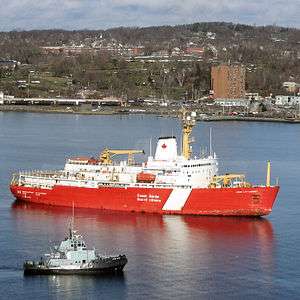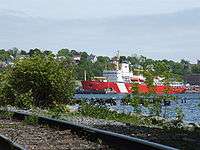CCGS Louis S. St-Laurent
 The icebreaker and flagship of the Canadian Coast Guard, CCGS Louis S. St-Laurent under way in Halifax Harbour, escorted by CFAV Glenside in the foreground. | |
| History | |
|---|---|
| Name: | Louis S. St-Laurent |
| Namesake: | Louis St. Laurent |
| Owner: | Government of Canada |
| Operator: | Canadian Coast Guard |
| Port of registry: | Ottawa, Ontario |
| Route: | Atlantic coastline and eastern Arctic |
| Builder: | Canadian Vickers, Montreal, Quebec |
| Launched: | 3 June 1966 |
| Commissioned: | 1969 |
| In service: | 1969-present |
| Refit: |
|
| Homeport: | CCG Base St. John's, NL (Newfoundland and Labrador Region) |
| Identification: | |
| Status: | in active service |
| General characteristics [2] | |
| Type: | Icebreaker |
| Tonnage: | |
| Displacement: | 15,324 tons (full)[3] |
| Length: | 119.8 m (393.04 ft) |
| Beam: | 24.38 m (79.99 ft) |
| Draught: | 9.91 m (32.51 ft) |
| Depth: | 16.3 m (53.48 ft) |
| Ice class: | Arctic Class 4 |
| Installed power: | 5 × Krupp MaK 16M453C (5 × 5,880 kW)[4] |
| Propulsion: |
|
| Speed: | 16 knots (30 km/h; 18 mph) |
| Range: | 23,000 nautical miles (43,000 km) |
| Endurance: | 205 days |
| Boats & landing craft carried: |
|
| Complement: | 46 |
| Aircraft carried: | 2 × MBB Bo 105 or equivalent |
CCGS Louis S. St-Laurent is a Canadian Coast Guard Heavy Arctic Icebreaker. Louis S. St-Laurent's home port is St. John's, Newfoundland and Labrador[5] and is stationed there with other vessels of the coast guard.
Named after the twelfth Prime Minister of Canada, The Right Honourable Louis St. Laurent, PC CC QC LLD DCL LLL BA. The vessel is classed a "Heavy Arctic Icebreaker" and is the largest icebreaker and flagship of the CCG.
Operations
Louis S. St-Laurent is based at CCG Base St. John's in St. John's, Newfoundland. The vessel's current operation tempo consists of summer voyages to Canada's Arctic where she supports the annual Arctic sealift to various coastal communities and carries out multi-disciplinary scientific expeditions. During the winter months, Louis S. St-Laurent sometimes operates in the Gulf of St. Lawrence to aid ships in transiting to Montreal, Quebec, although she usually only serves this assignment during particularly heavy ice years.
History


Louis S. St. Laurent was launched 3 December 1966 by Canadian Vickers Limited at Montreal, Quebec and commissioned in October 1969.[6]
From 8–22 September 1969 Louis S. St-Laurent sailed on the SS Manhattan expedition in the Northwest Passage. She was assisted by CCGS John A. Macdonald and the United States Coast Guard vessels USCGC Northwind and USCGC Staten Island [7]
During 1976 Louis S. St-Laurent, Captain Paul M. Fournier in command, made a partial transit of the Northwest Passage traveling from east to west, through Lancaster Sound, Peel Sound, and Victoria Strait.[8]
In 1979 Louis S. St-Laurent, Captain George Burdock in command, made a full east to west transit of the Northwest Passage. She assisted CCGS Franklin, and circumnavigated North America.[9]
Louis S. St-Laurent underwent an extensive and costly modernization at Halifax Shipyard Ltd. in Halifax, Nova Scotia between 1988-1993 which saw her hull lengthened as well as new propulsion and navigation equipment installed.
The modernization program was controversial as the government of Prime Minister Brian Mulroney had initially proposed building a class of mega icebreakers (the Polar 8 Project) for promoting Canadian sovereignty in territorial waters claimed by Canada; USCGC Polar Sea had made an unauthorized transit of Canada's Northwest Passage in 1985 early in Mulroney's administration, provoking a strong nationalist out-cry across the country. However, budget cuts in the late 1980s saw proposed expansions of the coast guard and armed forces scrapped. In compensation to the coast guard, the government opted to modernize the largest icebreaker in its fleet, Louis S. St-Laurent.
On 22 August 1994 Louis S. St-Laurent and USCGC Polar Sea became the first North American surface vessels to reach the North Pole.
In the summer of 2006, CBC TV's The National broadcast from Louis S. St-Laurent in a special series focused on climate change.[10]
The vessel was originally scheduled to be decommissioned in 2000 however a refit extended the decommissioning date to 2017. In the 26 February 2008 federal budget, the Government of Canada announced it was funding a $721 million "Polar Class Icebreaker" (named John G. Diefenbaker) as a replacement vessel for Louis S. St-Laurent.[11][12][13][14][15]
In 2014, with CCGS Terry Fox, Louis S. St-Laurent performed a cruise to the Arctic to map the undersea continental shelf. The two vessels were slowed by thick ice conditions.[16]
At 1:30 a.m. on 2 April 2015, Louis S. St-Laurent, arrived near Burgeo, Newfoundland and Labrador to take the damaged Canadian Coast Guard vessel CCGS Ann Harvey under tow. Ann Harvey, which had run aground near Burgeo, was already being towed by the lifeboat CCGS W.G. George when the icebreaker arrived. Louis S. St-Laurent took over the tow and brought Ann Harvery into Connoire Bay where Royal Canadian Navy divers could inspect the ship.[17]
In 2016 Louis S. St-Laurent was deployed to the Arctic carrying an international team of scientists mapping the sea floor. The first leg of the mission was a voyage to Norway mapping the Atlantic. This was to be followed by a 47-day leg to the North Pole.[18] Travelling with the Swedish icebreaker Oden, Louis S. St-Laurent's mission to the Arctic was the last of three performed in order to define Canada's claim to the Arctic continental shelf. While mapping during transit to the north, the scientists aboard the ship discovered a chain of 25-30 undersea volcanoes off the coast of Greenland.[16]
References
- 1 2 "Louis S. St-Laurent (6705937)". Equasis. French Ministry for Transport. Retrieved 2012-04-08. (registration required (help)).
- ↑ "CCGS Louis S. St-Laurent". Canadian Coast Guard. Archived from the original on 26 February 2012. Retrieved 3 April 2015.
- ↑ "CCGS Louis S. St-Laurent, 1994 Arctic Ocean Section". Cold Research and Engineering Laboratory Reports. p. 10. Retrieved 3 April 2015.
- ↑ "Krupp MaK Wins $21.6-Million Retrofit Contract For Canadian Icebreaker". American Shipbuilders. Retrieved 3 April 2015.
- ↑ "Vessel - Canadian Coast Guard". Archived from the original on 2010-06-17.
- ↑ Stephen Saunders, ed. (2004). Jane's Fighting Ships 2004-2005. Jane's Information Group. p. 95. ISBN 0710626231.
- ↑ Smith, William D. (1970). Northwest Passage, The Historic Voyage of the SS Manhattan. Markham, ON.: Fitzhenry & Whiteside Ltd, Publishers. ISBN 0-07-058460-5.
- ↑ MacFarlane, John M. (2012). "A List of the Early Partial Transits of the Canadian Northwest Passage 1921 to 2004". nauticapedia.ca. Retrieved 3 April 2015.
- ↑ MacFarlane, John M. (2012). "Full Transits of the Canadian Northwest Passage". nauticapedia.ca. Retrieved 3 April 2015.
- ↑ "The National visits Canada's North". CBC News. 27 October 2006. Archived from the original on 3 November 2006.
- ↑ "Budget 2008: Chapter 4 - Leadership at Home and Abroad". Government of Canada. 27 February 2008. Archived from the original on 2 March 2008. Retrieved 3 April 2015.
- ↑ "Arctic icebreaker, fishing port, tax break a start: northerners". CBC News. 27 February 2008. Archived from the original on March 1, 2008. Retrieved 2008-03-04.
- ↑ Windeyer, Chris (29 February 2008). "Feds to replace old icebreaker". Nunatsiaq News. Archived from the original on 3 March 2008. Retrieved 3 April 2015.
Ottawa will put aside $720 million this year to commission the icebreaker, which the government says will have better ice breaking capability than the Louis St. Laurent, considered the workhorse of the Coast Guard.
- ↑ Mullowney, Tara (4 March 2008). "Feds fall short: Ottawa must do more, politicians say". Southern Gazette. Retrieved 3 April 2015.
...and $720 million in funding for the Coast Guard will translate into a polar class ice-breaker that will be based in Newfoundland......“This is a bigger boat, so you can add to that.”
- ↑ Kives, Bartley (28 February 2008). "Red Amundsen our flag in white Arctic". Winnipeg Free Press. Archived from the original on 2008-02-27. Retrieved 3 April 2015.
- 1 2 "Research ship mapping Arctic Ocean near North Pole". CBC News. 20 August 2016. Retrieved 20 August 2016.
- ↑ "Coast guard ship Ann Harvey anchored near Burgeo after striking bottom". CBC News. 2 April 2015. Retrieved 3 April 2015.
- ↑ MacDonald, Michael (21 July 2016). "Canada sending largest icebreaker to North Pole to bolster Arctic claim". CTV News. The Canadian Press. Retrieved 27 July 2016.